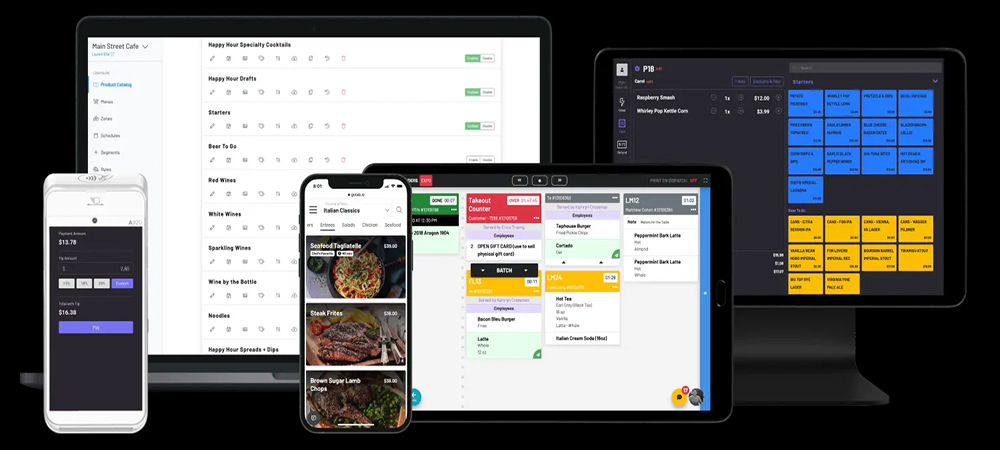Oct 26, 2022Restaurant commerce platform company GoTab is offering HF RFID technology-based solutions to enable patrons of restaurants and other businesses within a venue to make payments using a single card or wristband. With the solution, users can create a "tab" by linking their payment information to their card and then tapping it at a variety of points of sale (POS), such as multiple restaurants or bars in a food court, festival or resort.
GoTab's RFID solution, released this year, leverages RFID so that consumers can tap their band or card against a reader to charge items from participating locations back to an account, making purchasing more seamless for individuals or groups. The technology is designed to benefit customers and vendors alike by making transactions more frequent due to their ease. The solution targets operators at multi- or single-unit restaurants, as well as food halls, festivals and other entertainment venues, to provide a quick and easy commerce experience, according to Tim McLaughlin, GoTab's co-founder and CEO.
Since its founding in 2016, the company has offered mobile order and payment technologies for the restaurant and hospitality industries. Its solutions include a payment application, in addition to an all-in-one restaurant POS system. The company's goal is to enable patrons to order and pay for meals or services through a server, or with a payment app on their mobile phones.

GoTab's RFID-based payment solution
Guest Ordering and Engagement
McLaughlin launched his first restaurant and brewery in 2015. Watching first-hand the development of e-commerce for food purchasing, he recognized an opportunity for restaurant-based solutions to improve operational efficiency and quality of service. About a year after GoTab launched in northern Virginia (in the Washington, D.C., metro area), the company began building a QR code-based ordering system.

Tim McLaughlin
The QR code payment solution is predominantly used by restaurant customers, McLaughlin says. "We were the best product in that category because we've been doing it since 2017," he explains. Over time, however, the company has been building onto its solutions. "We continued adding feature after feature after feature, so now we offer a full POS solution." The GoTab software manages the data required to capture a customer's order, display that data in the kitchen and provide kitchen operations, along with fulfillment and pick-and-pack data for ecommerce orders, among other features.
While QR codes enable contactless ordering and payments, RFID can make that process a matter of simply tapping against a reader. "A lot of our unique features are really focused on on-premise [services]," McLaughlin says, "and that that's really where the RFID technology comes into play." The goal, he adds, was to address the many inconveniences patrons experience at sites in which they order food or drinks from a variety of vendors.
"I would actually say the food hall experience can be pretty terrible," McLaughlin says, noting that many people have experienced "food court" dining. One member of a party looks for seating and "holds" the table, while others walk through the businesses, shopping for and individually buying goods from the restaurants of their choice. It can be a hectic process, one that GoTab aims to make simpler.
How the System Works
"The unique features of our product have to do with customer identity and tracking," McLaughlin says. The system knows the user's identity based on their account information, as well as with which business they interact and what they are ordering. In advance of an event or upon entering a location, guests receive a branded card or wristband unique to each person, to which they can allocate funds from a credit or debit card. The solution can provide a tab for an individual user with a single account, or a family or group who share an account, and allocate maximum balances for some members, such as children.
For instance, a family of four could purchase a tab with a $20 limit placed on each of the two children's activities. All would receive a wristband with a built-in 13.56 MHz NXP Semiconductors Mifare RFID tag compliant with the ISO 15693 standard. The unique ID number encoded on each wristband would be associated with that single account. The wristbands worn by the two children could also link to a $20 balance, while the parents' wristbands could enable unlimited payments. From there, guests could charge food or retail items from multiple merchants, with a simple tap of the card or band at each purchase station.
Users can check their balance by tapping their band to a payment terminal, and the system will display the existing tab. That could include something like 12 ounces of beer purchased at one site and a slice of pizza elsewhere for an additional amount. Payments are received through the pre-allocated funds, or they can be made at the end of the RFID wristband's use, based on purchases. If prepayment has been made to the account, the technology enables an automatic refund for guests if they spend less than what was loaded onto their card or band.
In some cases, the system can enable payment to patrons' existing account on the restaurant's property, such as a hotel room in a resort. One of the first adopters of the RFID-based solution is The Market at Malcolm Yards, located in Minneapolis, Minn. The facility offers prepared foods that include soups, sandwiches and cheese plates, provided by a choice of businesses, all under a single roof. The system allows patrons to make payments at any of these sites, using their single GoTab-based tab.
The company also provides its software for RFID self-pour solution provider PourMyBeer. The solution typically consists of a self-pour wall with a built-in RFID reader and antennas from PourMyBeer, which use the GoTab software to link a particular patron with an ID wristband or card. The software captures RFID read data, along with the measured quantity of beer or other drinks they pour, then bills users accordingly.
Combining Merchant Payments on a Single Tab
While contactless payments are commonplace, and while some RFID-based payment systems are provided for parks and other venues, McLaughlin says GoTab is among the few that provide a single tab for payments across multiple businesses. "Even though they are all separate businesses," he states, "the consumer doesn't have to worry about that—the fact that the pizza vendor is separate from the beer vendors, which are separate from the cake or the pie vendor."
Some GoTab scenarios that could be created with RFID functionality include a corporate party at which a company could provide wristbands to employees, each with a prepaid balance (say, $50). Alternatively, a company could have a single tab with open access to all employees so that individual payments would simply be deducted from the company's account. What's more, the technology can accommodate limitations on purchasing based on a person's age.
For instance, teenagers would be identified at the point of sale if they tried to purchase alcoholic beverages. Another feature is that the system can notify individuals when their order is ready. The first time a patron uses the GoTab system, they could provide their phone number to receive notifications. Then, if they order food, they will receive a text message automatically once their food is ready to be picked up.
GoTab is technology-agnostic. The software platform works with most RFID-based POS systems and will run on iOS, Android and Windows operating systems. And while GoTab has an app, guests don’t have to use it. The solution is being adopted by entertainment-oriented venues that specifically requested the RFID functionality for its ability to provide fast transactions with the tap of a wristband. Deployments to date have mostly been in North America, while U.K. sites will be using the technology soon as well.
The solution is available globally. Adoption is taking place in metropolitan areas in the Northeast, California and Hawaii, typically at locations frequented by tourists, where it's difficult to attract workers to jobs behind a bar or in a kitchen. In the future, the solution is expected to enable payments directly from an RFID-enabled Apple iPhone.
Key Takeaways:
- GoTab's solution enables individuals and groups to use RFID wristbands or cards to pay for goods from multiple vendors, with payments drawn from a single tab.
- In the future, the company plans to offer the solution for smartphone payments using an iOS phone, similar to the Apple Pay app.

